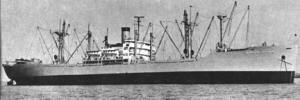|
LIBERTY / VICTORY
SHIP FACTS
The initial Liberty ship design allowed a maximum speed
of only 11 knots, making them easy prey for submarines, so early in
1942 designs for a 15 knot ship were begun.
The first of 534 Victory ships, the SS United Victory,
was launched on February 28 1944,
and like the Liberty construction technique, used an assembly-line
methodology. The next 34
Victory ships were named for each of the Allied nations; the subsequent
218 were named after American cities, the next 150 were named after
educational institutions, and the rest received miscellaneous names.
Attack Transports were named after Counties, except one named after
President Roosevelt's personal Secretary, Marvin H. McIntyre.
The Victory ship (officially the VC2 class) was 455 feet long and
62 feet wide. Her cross-compound steam turbine with double reduction
gears developed 6,000 (AP2 type) or 8,500 (AP3 type) horsepower. One
diesel Victory, the Emory Victory (VC2-M-AP4) was built. The VC2-S-AP5
was the designation given to Attack Transports built for the Navy (Haskell
class). The three AP7 type were Victory's laid as AP3 or AP5 which were
cancelled after VJ Day, and completed as combined passenger/cargo ships
for the Caribbean trade. |
VICTORY SHIP CLASS
PHOTO AND DIAGRAM


Illustrations from Victory ships and tankers; the history of the "Victory"
type cargo ships and of the tankers built in the United States of America
during World War II, by L. A. Sawyer and W. H. Mitchell. Cornell Maritime
Press, Cambridge, Md.,1974.
|
Paraglide Ship's News
Aboard the Queen Mary Monday, December 31, 1946
While this ship's newspaper is not 508-centric, it is
significant for the times, plus, at least 54 men of the 508th regiment
were aboard the Queen Mary during this run.
Read
Paraglide
Ship's News [Warning - 7 Meg file!]
Many thanks to
Arthur Rottier of the Netherlands for sharing this document |





